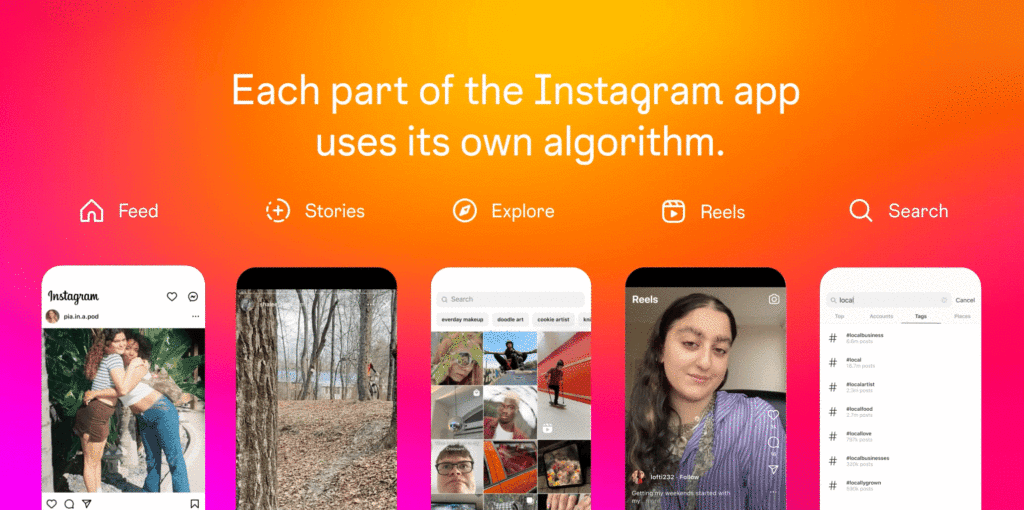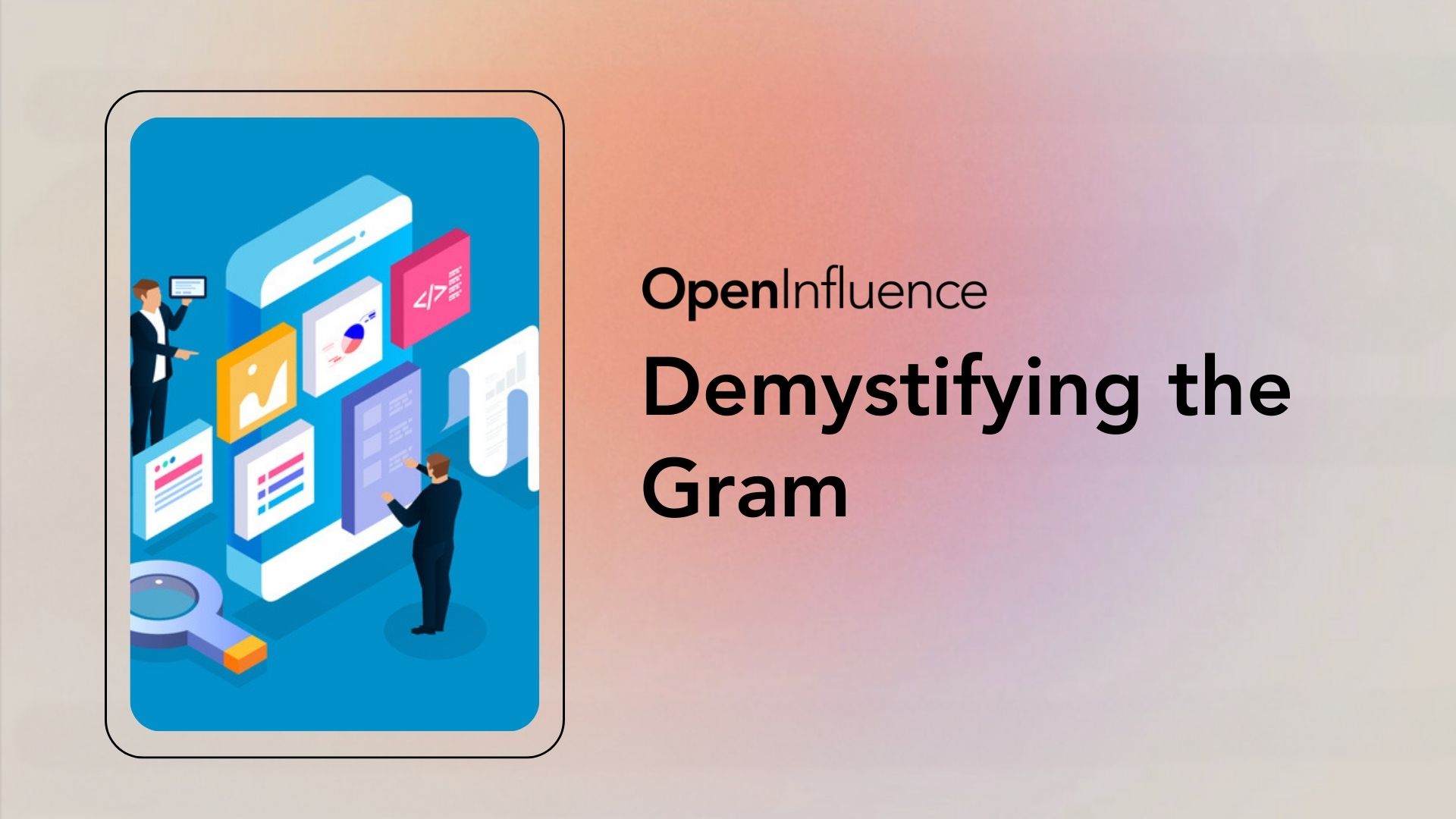Instagram sought to provide more clarity on the process that determines which content is seen by users of its platform, along with sharing some best practices for creators hoping to get their content in front of as many people as possible.
The first myth that the Meta-owned application sought to clear up was that of “the Instagram algorithm,” as head of Instagram Adam Mosseri explained in a blog post that the platform uses “a variety of algorithms, classifiers, and processes, each with its own purpose,” and adding that each section of the app is populated by its own algorithm: Feed, Stories, Explore, Reels, and Search.

Source: Instagram
Feed
Feed is the core of the Instagram app, where users see carousels, photos, and videos from accounts they follow, as well as from accounts recommended by Instagram, and ads.
The first factor Instagram uses to populate Feed is recent posts shared by accounts the user follows, joined by posts from accounts that they do not follow but that may be of interest.
Instagram determines the latter through signals including what the user has recently engaged with, followed, or liked, and Mosseri clarified that the goal is to serve up a balance of posts from followed accounts and recommended accounts.
Mosseri outlined the most important signals that Instagram uses when populating Feed, in order of priority:
- Activity: Instagram uses posts a person has commented on, liked, saved, or shared to try to understand that person’s interests.
- Information about posts: This includes total likes, as well as the speed at which users are commenting on, liking, saving, or sharing the post. The post’s location and time are factored in, as well.
- Information about the account behind the post: Signals incorporated include how many times people have interacted with the account in recent weeks.
- Interaction history: Instagram gauges how interested a person is in seeing posts from a specific account through signals such as whether the two accounts comment on each other’s content.
Instagram uses all those signals to predict how likely a user is to interact with a post. For Feed, the five most important predictions are likelihood to spend a few seconds on a post, to comment on it, to like it, to share it, or to tap on the profile photo of the account behind the post. Mosseri explained, “The more likely you are to take an action, and the more heavily we weigh that action, the higher up in Feed you’ll see the post.”
Factors that may change that process include a desire to avoid showing too many posts from the same account or too many suggested posts consecutively.
Posts flagged by Meta’s third-party fact checkers, or from accounts that are repeatedly flagged, will be downgraded, along with posts that Instagram predicts the user is likely to report.
Content that violates Instagram’s Community Guidelines will be removed altogether.
Stories
Instagram users see Stories from accounts they follow, as well as ads.
Signals that the platform uses to determine which Stories users see include:
- How often the user views an account’s Stories.
- How often the user engages with an account’s Stories, such as by sending a direct message or liking the content.
- The relationship between the user and the account behind the Story, so that Instagram can determine how likely it is that they are family or friends.
Much like Feed, Instagram then attempts to predict which Stories a person will find more relevant and valuable and show that content higher in the Stories tray.
Community Guidelines and the criteria mentioned above for downranking content in Feed apply to Stories, as well.
Explore
Unlike Feed and Stories, which are geared toward ensuring that users see content from accounts they follow, Explore is the part of Instagram that helps people, well, explore and find new sources of content.
Explore is populated by photos and videos from accounts a person does not follow, and the first step toward determining what content to serve to each user is examining past activity such as posts they have commented on, liked, saved, or shared.
Much like Feed and Stories, the next step is to determine which content the user will likely be most interested in, through signals starting with:
- The total and speed of comments, likes, saves, and shares, with Mosseri pointing out, “These signals matter much more in Explore than they do in Feed or in Stories.”
- Delivering posts that are similar to content users have previously commented on, liked, saved, or shared within the Explore tab.
- Whether the user has interacted with the account behind a post in the past.
- How many times people interacted with the account behind the post in recent weeks.
Mosseri wrote that since Explore surfaces content from people that users don’t follow, Instagram adds to its Community Guidelines with Recommendations Guidelines, which include not recommending content featuring people using certain regulated products such as pharmaceutical drugs, tobacco, or vaping products, as well as not recommending content depicting violence.
If an account repeatedly shares content that runs afoul of Instagram’s Recommendations Guidelines, its posts will be ineligible for recommendation for a specific period.
Reels
Instagram’s Reels feature was also crafted to help users find new content, particularly entertainment. Like Explore, much of what people see is short-form videos from accounts they do not already follow, so the process of populating the tab is similar to that for Explore.
The platform asks users for feedback on particular Reels in order to train itself on what types of content to show people, and its predictions, in order of importance, are how likely the user is to reshare a Reel, to watch it all the way through, and to go to the audio page for the Reel, presumably to create their own Reel with the same audio.
Mosseri said the most important signals Instagram uses to decide what people see in the Reel tab are:
- Reels a person recently commented on, engaged with, liked, reshared, or saved.
- Any history of interaction between the user and the account that posted the Reel.
- Signals related to content within the Reel, such as its audio track or visuals, as well as the popularity of the Reel.
- Information about the account that posted the Reel, including level of engagement and total followers.
Factors that may cause a Reel to be downgraded include borders, low-resolution video, muted audio, political issues, reposted Reels, text representing the majority, and watermarks.
Best Practices for Creators
Instagram shared the following tips for how content creators can improve the reach of their posts:
- Share content you created yourself, which has not previously been posted to Instagram. The platform said on the topic of reposted content, “As we recommend more content on Instagram, it’s important that the credit, distribution, growth, and monetization go to the original creator, and we’re continuing to work toward this. We’re less likely to recommend reposts of a Reel that’s already on Instagram, content with noticeable watermarks, or accounts that regularly collect and reshare others’ content on their Feed.”
- Reels must be 90 seconds or shorter in order to be recommended.
- Use Instagram’s Collabs feature to team up with other creators on posts that are shared to followers of both creators. Also, use Enhanced Tags to include creators’ public and self-identified profile categories.
- Include relevant keywords in your bio, captions, content, and hashtags to boost the chances of being discovered via Search.
- Encourage top fans to add your account to their Favorites so that your content will appear higher in their Feed.
- Use the platform’s insights to divide accounts reached into followers and non-followers, determine patterns, and learn which posts are generating more reach.
- Check your Account Status to make sure you have no violations of the platform’s Community Guidelines or Recommendations Guidelines that would cause your content to be ineligible for recommendation.
- Use the Remix tool to take a popular Reel and add your own spin to it.
Open Influence’s team stays on top of the trends and is here to make sure you make the most of your creator marketing campaigns. Open Influence is a global creator marketing agency dedicated to creating compelling campaigns that utilize all the latest features. Don’t hesitate to reach out to us today!
Credit for image in banner: sesame/iStock.






